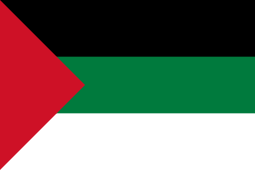- This page was last modified on 17 October 2025, at 10:18. Suggest an edit.
al-Najjada facts for kids
| Al-Najjada النجادة |
|
|---|---|
 |
|
| Foundation | 8 December 1945 |
| Dates of operation | 1945–1947 |
| Dissolved | Late December 1947 |
| Headquarters | Jaffa, Palestine |
| Ideology | Arab nationalism Pan-Arabism Anti-Zionism |
| Size | 8,000 (1946) 3,000 (1947) |
| Battles and wars | 1948 Palestine War |
al-Najjada (Arabic: النجادة) was a Palestinian Arab youth group. It was like a scout movement but also included military-style training. It started in Jaffa, in Palestine (which was then under British rule), on December 8, 1945.
The group was led by Muhammad Nimr al-Hawari as the General Commander. Rashad al-Dabbagh was the Secretary General. Many of its officers had served in the British Army. Al-Najjada's main office was in Jaffa. By 1946, it had about 8,000 members. However, by 1947, this number dropped to around 2,000 to 3,000 members. The group also did not have many weapons.
Contents
What Al-Najjada Believed
When al-Najjada was formed, it published its main goals on December 8. These goals were:
- To bring young people together and create a strong national feeling among them. They wanted to teach them discipline and obedience.
- To connect Palestine with other Arab countries. They hoped this would help Arabs live with dignity and spread ideas of Arab unity, freedom, and equality.
- To see Palestine as an Arab country. They believed it shared rights and duties with other Arab nations.
- To strongly oppose the Zionist movement. They saw it as unfair and based on aggression.
- To stop divisions based on local areas, tribes, or different beliefs. They wanted everyone to work together.
How Al-Najjada Operated
Al-Najjada had 11 branches in different cities. These included Jaffa (their main office), Haifa, Acre, Nablus, Beersheba, Tiberias, Jerusalem, Tulkarem, Gaza, Majdal, and Nazareth. Each branch was divided into smaller groups.
The group was very active in Southern Palestine. They aimed to help Palestinian society by improving the education and morals of Arab youth. Their training included physical exercises, drills, and basic military skills like rifle shooting. They also taught lessons about Arab nationalism, which is the idea of Arab people having their own united and independent nations.
Muhammad al-Hawari tried to make al-Najjada similar to the Haganah, another group in the region. However, al-Najjada mostly held noisy parades in town squares. They did not do much military activity. Still, al-Najjada, along with another group called al-Futawa, was seen as a possible start for a strong Palestinian Arab youth organization.
Attempts to Unite Groups
In October 1946, there was an effort to combine al-Najjada with another youth group, al-Futuwa. This idea came after a parade in Jaffa. Leaders wanted all Palestinian Arab youth groups to be under the control of the Palestine Arab Party.
A special committee was formed to look into this merger. However, al-Najjada members raised many questions about the legal, money, and management parts of the merger. This made it difficult for the committee to combine the groups.
The End of Al-Najjada
As the civil war in Palestine began in 1947, al-Hawari was in charge of defending Jaffa. But he later left Jaffa for Ramallah in late December 1947.
After this, al-Hawari went to Egypt. Another leader, Amin al-Husayni, prevented him from returning. This led to Amin al-Husayni gaining control of Jaffa. During these events, the al-Najjada organization was broken up. This meant that the Palestinian Arab leadership did not have a national youth group like al-Najjada when the 1948 Palestine War started.
